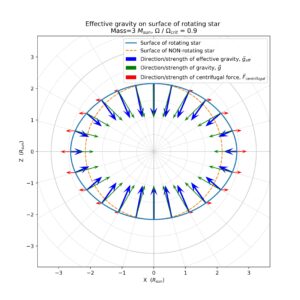Be stars are a type of star that rotate so rapidly that the centrifugal force causes their equators to bulge outward. If they rotate fast enough, they can eject material into an orbiting disk. To form such a disk, these stars must be spinning near their critical velocity (the speed where the centrifugal force at the equator throwing material outwards balances the force of gravity pulling material inwards). However, spectroscopic observations of Be stars show that they are only rotating at about 70% critical, which isn’t fast enough to eject material into orbit and create the disks we see. These observations have assumed that the stars rotate as solid bodies.  The goal of my project is to investigate whether differential rotation along the surface (meaning that different parts of the surface rotate at different rates) could explain why spectroscopic observations might underestimate the true rotation rate. To test this, I have calculated the shape and rotation rate of a rotating star and used a library of spectral data to simulate the total spectra produced by the star. I have successfully applied this method to a few test cases, such as an ellipsoid-shaped star, and verified that the effects of rotation on the resulting spectra match my expectations. I plan on applying this method to a differentially rotating star to see what effects the differential rotation has on the spectra.
The goal of my project is to investigate whether differential rotation along the surface (meaning that different parts of the surface rotate at different rates) could explain why spectroscopic observations might underestimate the true rotation rate. To test this, I have calculated the shape and rotation rate of a rotating star and used a library of spectral data to simulate the total spectra produced by the star. I have successfully applied this method to a few test cases, such as an ellipsoid-shaped star, and verified that the effects of rotation on the resulting spectra match my expectations. I plan on applying this method to a differentially rotating star to see what effects the differential rotation has on the spectra.

